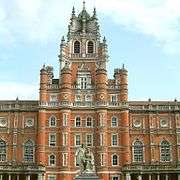Information Security Group
Founded in 1990, the Information Security Group (ISG) at Royal Holloway, University of London, is an academic security group, with 18 established academic posts, 10 visiting Professors/Fellows and over 90 research students.[1] The Founder Director of the ISG was Professor Fred Piper, and the current Director is Professor Keith Mayes.
In 1998 the ISG was awarded a Queen's Anniversary Prize in recognition of its work in the field of information security.[2] It has also been awarded the status of Academic Centre of Excellence in Cyber Security Research (ACE-CSR),[3] hosts one of only two UK Centres for Doctorial Training in cyber security[4][5] (led by Professor Carlos Cid).
In 1992, the ISG introduced an MSc in information security, being the first university in the world to offer a postgraduate course in the subject.[6][7] In 2014 this course received full certification from GCHQ.[8]
Research topics addressed by the ISG include: the design and evaluation of cryptographic algorithms, protocols and key management; provable security; smart cards; RFID; electronic commerce; security management; mobile telecommunications security; authentication and identity management; cyber-physical systems; embedded security; Internet of Things (IoT); and human related aspects of cyber security. The current Director of Research is Professor Jason Crampton, and the Director for Research Impact is Professor Kenny Paterson.
The ISG includes a Smart Card Centre (SCC) that was founded in October 2002 by Royal Holloway, Vodafone and Giesecke & Devrient, for training and research in the field of Smart cards, applications and related technologies: its research topics include RFID, Near Field Communication (NFC), mobile devices, IoT, and general embedded/implementation system security. In 2008, the SCC was commissioned to perform a counter expertise review of the OV-chipkaart by the Dutch Ministry of Transport, Public Works and Water Management.[9] The SCC has received support from a number of industrial partners, such as Orange Labs (UK), the UK Cards Association, Transport for London and ITSO. The current Director of the Smart Card Centre is Dr. Konstantinos Markantonakis.
The ISG also includes a Systems Security Research Lab (S2Lab), which was created in 2014, to investigate how to protect systems from software related threats, such as malware[10] and botnets. The research in the lab covers many different Computer Science-related topics, such as operating systems, computer architecture, program analysis, and machine learning. The current Lab Leader is Dr. Lorenzo Cavallaro.
References
- ↑ "Royal Holloway | Staff Directory | Information Security home". www.royalholloway.ac.uk. Retrieved 2016-03-07.
- ↑ "Previous Prize-winners". www.royalanniversarytrust.org.uk. Retrieved 2016-03-11.
- ↑ "Academic Centres of Excellence in Cyber Security Research". www.epsrc.ac.uk. Retrieved 2016-03-11.
- ↑ "CDT in Cyber Securityat Royal Holloway". www.epsrc.ac.uk. Retrieved 2016-03-11.
- ↑ correspondent, Sean Coughlan BBC News education. "£7.5m university fund to train cybersecurity experts". BBC News. Retrieved 2016-03-11.
- ↑ "Information security: students aim to peer into the mind of the cyber thief". Telegraph.co.uk. Retrieved 2016-03-11.
- ↑ Ciechanowicz, Chez; Martin, Keith M.; Piper, Fred C.; Robshaw, Matthew J. B. (2003-01-01). Irvine, Cynthia; Armstrong, Helen, eds. Ten Years of Information Security Masters Programmes. IFIP — The International Federation for Information Processing. Springer US. pp. 215–230. doi:10.1007/978-0-387-35694-5_21. ISBN 9781475764918.
- ↑ "Developing the Cyber Experts of the future - GCHQ certifies Master's Degrees in Cyber Security". www.gchq.gov.uk (Press release). Retrieved 2016-03-11.
- ↑ Waterstaat, Ministerie van Verkeer en. "20083843 Bijlage 1 OV Chipkaart 'Counter Expertise' Review of the TNO security analysis of the Dutch OV-Chipkaart". www.rijksoverheid.nl (in Dutch). Retrieved 2016-03-11.
- ↑ Campbell, MacGregor. "Phone invaders: The rise of mobile malware". New Scientist. Retrieved 2016-03-11.
External links
- Information Security Group website
- Smart Card Centre website
- Systems Security Research Lab website
- Royal Holloway, University of London website
